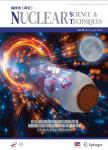Electrorefining of nickel from nickel–chromium alloy in molten LiCl–KCl
Electrorefining of nickel from nickel–chromium alloy in molten LiCl–KCl作者机构:Department of Radiochemistry Shanghai Institute of Applied Physics Chinese Academy of Sciences
出 版 物:《Nuclear Science and Techniques》 (核技术(英文))
年 卷 期:2019年第30卷第9期
页 面:47-54页
核心收录:
学科分类:080603[工学-有色金属冶金] 08[工学] 0806[工学-冶金工程] 0807[工学-动力工程及工程热物理] 0827[工学-核科学与技术] 0703[理学-化学] 0702[理学-物理学] 0801[工学-力学(可授工学、理学学位)]
基 金:supported by the National Nature Science Foundation of China(Nos.21601200 and 21771188) Strategic Priority Research Program and Frontier Science Key Program(Nos.XD02030000 and QYZDY-SSW-JSC016)of the Chinese Academy of Sciences
主 题:Electrorefining Nickel Molten salt Alloy LiCl–KCl
摘 要:Electrorefining of nickel in LiCl–KCl melt was investigated using electrochemical techniques. Nickel products after electrorefining were characterized by X-ray diffraction, X-ray fluorescence, and scanning electron microscopy. Both cyclic voltammetry and square wave voltammetry results suggested that Ni^2+ was directly reduced to Ni metal in LiCl–KCl. Based on a preliminary study on the electrochemical behavior of nickel and chromium, electrorefining was carried out under constant potential, whereupon deposits were formed on the cathode. The purity of nickel increased from 72.62% in the original alloy to 99.83% in cathodic deposits, as determined by inductively coupled plasma atomic emission spectroscopy analysis. Almost all the nickel in the alloy could be recovered during the electrochemical process with[90% current efficiency. A lower concentration of NiCl2 in LiCl– KCl was found to be favorable for nickel electrorefining, as increased NiCl2 concentration caused severe corrosion of the nickel anode at the gas–liquid interface due to the accumulation of Cl2 gas.



